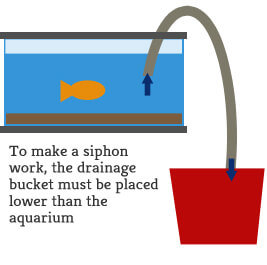How to Use an Aquarium Gravel Cleaner
A siphon which is exactly what an aquarium gravel cleaner is, works by using the forces of gravity and hydrostatic pressure. It’s not important to know the exact physics behind these things but following these tips will ensure your gravel cleaner works efficiently:
- A siphon will only work if the tube in the goldfish aquarium that is being cleaned is higher than the other end of the tube in the drainage bucket.
- When a siphon tube is placed into the higher goldfish aquarium water and is hanging up and over the side into your aquarium cleaning bucket on the floor, nothing will happen.
- In order to make it work, the tube must be entirely full of water with no pockets of air.
- Any sections with air in the up portion of the process, will break the siphon water flow.
- When there is no air in the tube, gravity will not only push the aquarium water downward but also up through the tube.
- When the water makes it over the top, gravity pulls it down and out through the other end of the tube.
- This process will also create a pull on the water still moving up the up section and thus keeps the cycle moving.
Gravity
To get water to move up hill or up and out of a goldfish aquarium, gravity must be used. Gravity is the downward force that pushes the water down and outward against the aquarium’s glass.
Hydrostatic Pressure
Hydrostatic pressure is all about the equilibrium of a fluid based on its pressure. It’s actually much more complex than that but for our purposes think of hydrostatic pressure as the reason for the movement.
Why use an Aquarium Gravel Cleaner
Beneficial bacteria grows and lives in the goldfish aquarium gravel substrate making it a bad idea to remove it from the tank to clean. When aquarium gravel is thrown into a kitchen sink and cleaned with soap or bleach, all that beneficial bacteria is killed. This will throw off the nitrogen cycle in the goldfish tank. Using an aquarium gravel cleaner will remove waste particles but leave the beneficial bacteria.

Getting the Siphon Process Started
There are several methods for completely filling the siphon tube with water and remove all air bubbles:
- Place the tube in the tank horizontally to flood the entire tube. Then by acting quickly, pull one end of the tube up and out of the tank and direct the water into your drainage bucket. If you are quick enough, no air will get into the tube and allow the siphon process to begin.
- In conjunction with using the previously mentioned method, also try moving the downward facing end of the tube in the aquarium up and down repeatedly in a quick motion. You should notice that after ever up and down, the water level in the tube should rise. Once it rises to the top of the aquarium rim, let gravity take over on the down and out side of the tube.
- The water in the tube can be sucked through manually. This is not recommended for sanitary reasons. The tube probably has germs and bacteria on it and surely no one wants to get a mouth full of dirty fish tank water.
- You can buy suction starter device to get the process started
- You can also buy a battery powered aquarium gravel cleaner and make your life very easy.
How to Clean The Gravel
Helpful Extras
Get a siphon tube with a safety on/off valve to stop the water from flowing. This is helpful to have in the event the drainage bucket is in danger of overflowing
Get a tube clip that secures the end of the siphon hose to the cleaning bucket. The clip helps keep the dirty tank water from going anywhere else but into the bucket.
Start the siphon process and plunge the aquarium gravel cleaner into the gravel. Don’t siphon the top of the water, the majority of the waste is on the bottom. By pulling up and down on the tube, waste particles are freed and will get sucked up by the aquarium gravel cleaner. While continuing this motion, move the tube every few seconds in a grid pattern back and forth until the all the gravel is cleaned.
Remember to stop siphoning before the cleaning bucket overflows. Use this dirty aquarium water to clean any filters and then dispose of the dirty water by water house plants as it is rich in nitrogen.
Reviewed By: Tim Winter

Tim Winter has a strong affection for pets and wildlife. His years of experience caring for various types of pets has led him to share his knowledge with others on the best practices in pet care. Tim holds a Bachelor of Science from the University of Oregon School of Journalism and Communications.

I rinsed of my gravel in the sink with water. It had food on it that I didn’t want to sit there and poison my fish. Is that okay?
i am looking for a mgravel pump that stays in the tank i thank it has its own filter system dont no but i seen one on the net but cant find it
try looking at this post on aquarium filters. I think what you are talking about is called an under gravel filter. I had on once and it worked well but when it came time to cleaning, I had to dig it up to remove the dirt and debris. a reverse under gravel filter is a good option though.